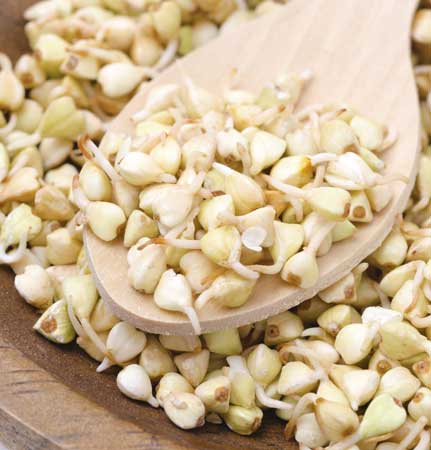Germinated buckwheat and health; FDA Food Safety Challenge finalists
NEWS
 Germinated buckwheat more nutritious
Germinated buckwheat more nutritious
Researchers at Wilmar (Shanghai) Biotechnology Research and Development Center Co. found that germinating buckwheat boosted its nutritional value, according to a study that appeared in the Journal of Food Science.
During germination, seeds experience chemical changes in order to make their stored nutrition available to the new plant. In this study, the researchers looked at how nutritional ingredients, antinutritional components, chemical composition, and antioxidant activities in buckwheat changed over a 72-hour germination period. They observed a significant increase in crude protein, reducing sugar, total phenolics, total flavonoids, and condensed tannins. The scientists found that the increase in flavonoids enhanced antioxidant activities in the buckwheat.
“Germinated buckwheat had better nutritional value and antioxidant activities than ungerminated buckwheat,” they write, “and it represented an excellent natural source of flavonoids and phenolic compounds, especially rutin and C-glycosylflavones.” As a result, the researchers concluded that germinated buckwheat shows potential as a functional food for promoting health.
FDA Food Safety Challenge finalists
The U.S. Food and Drug Administration (FDA) announced the five finalist teams in its Food Safety Challenge, a program it introduced in September 2014 to spur innovation in creating pathogen-detecting technologies for use with produce. The finalists, which were chosen from 49 submissions, are as follows: Auburn University; Pronucleotein; Purdue University; University of California, Davis, Bart Weimer, and Mars; and University of Illinois at Urbana-Champaign and Purdue University.
Each team will receive $20,000 and move on to the next stage of the competition. The finalists will have the opportunity to refine and clarify their concepts under the guidance of FDA food safety and pathogen-testing experts before participating in a boot camp with FDA experts to help strengthen their concepts and ensure they are applicable to the FDA’s testing process. Each team will present their final proposals to the judges—experts from the FDA, Centers for Disease Control and Prevention, and the U.S. Dept. of Agriculture—before a live audience on July 7, 2015. The winner (or winners) will receive the remainder of the $500,000 total prize.
Donkey milk as functional beverage
Fermented donkey milk shows potential for use as a health and nutraceutical food, particularly for those who cannot tolerate lactose or cow milk protein, according to a recent study published in the Journal of Food Science.
In the study, researchers were especially interested in decreasing lactose content through fermentation and studying antioxidant activity in yogurt made from donkey milk. Two yogurts—a standard yogurt (YC) and a probiotic yogurt (YP; Lactobacillus acidophilus, Lactobacillus casei)—were stored for up to 30 days at 4°C. Lactose content gradually decreased in both yogurts and antioxidant activity increased, with a higher level shown in the YP as a result of lactic acid bacteria.
“LAB are able to hydrolyze lactose, casein, and whey protein with release of a large number of organic acids, peptides, and amino acids that are protective agents to help [the] human body to reduce oxidative damage,” write the researchers. “This work highlights that the fermented probiotic donkey milk could allow development of novel foods useful to meet the needs of consumers with lactose or cow milk protein intolerance.”
 Hay can control Swiss cheese holes
Hay can control Swiss cheese holes
Introducing hay microparticles into microfiltered milk can reliably create holes in Swiss-type cheeses, according to a study published in International Dairy Journal by a team of Swiss researchers.
For at least a century, researchers have been investigating eye formation in Swiss-type cheeses such as Emmental, and the prevailing theory pointed to carbon dioxide released by bacteria. As milk has gotten cleaner through filtration, the resulting cheeses have contained drastically fewer eyes, though cheeses made in summer tended to contain more. For this reason, the Swiss team theorized that “hay and grass feeding could affect the entry of microparticles into raw milk.”
To test the hypothesis, they added hay powder to cheese milk before cheese production, and their results “demonstrate that microparticles of plant origin act as eye nuclei that control the number (P<0.001) and the size of the eyes in cheese in a dose-dependent manner,” according to the study.
White House directs antibiotic use
President Obama has signed a presidential memorandum directing the federal government to purchase its meat from sources that use antibiotics responsibly, the White House announced at its White House Forum on Antibiotic Stewardship on June 2. The forum was held as part of an ongoing effort to combat antibiotic resistance and ensure the responsible use of antibiotics.
The memorandum aims to introduce these responsibly raised meats and poultry into certain federal cafeterias first before expanding them into all federal cafeterias serving civilian federal employees; the final step in the three-tiered process would make responsibly raised meats and poultry available in all federal facilities by 2020, according to the White House fact sheet.
The White House also high-lighted efforts underway by various private sector companies in fighting antibiotic resistance, such as hospitals and other health-care facilities prescribing fewer antibiotics to humans, farmers phasing out antibiotic use in their flocks, and food companies and retailers choosing to serve meat free from antibiotics.
Restaurant sales surpass grocery stores
December 2014 marked the first time on record that monthly sales at restaurants were higher than those at grocery stores, according to the National Restaurant Association (NRA). In a May press release, the NRA notes that a shift toward restaurants could be seen over the last 10 months, with restaurant sales exceeding grocery store sales by $1.5 billion in April 2015—compared with the $1.6 billion lead grocery stores saw in June 2014.
According to the NRA, the increase in spending at restaurants coincides with a sharp decline in gas prices, and in research the association commissioned from ORC International, of the 80% of consumers who say lower gas prices benefited their household finances, 49% say lower gas prices have encouraged them to make more purchases at restaurants. The NRA also cites increased consumer confidence as another factor in the uptick in restaurant spending.
What’s new with food companies
• Archer Daniels Midland Co. agreed to acquire Chinese sweetener manufacturer Meiweiyuan Biotechnology. It also acquired the tree nut and seed processing assets and operations of California Gold Almonds in Modesto, Calif.
• Barry Callebaut opened its first cocoa application center in Asia Pacific.
• ConAgra Foods will invest around $50 million to expand its manufacturing facility in Waterloo, Iowa.
• Duravant, an equipment manufacturer serving the food processing, packaging, and material handling sectors, acquired Hamer, which manufactures packaging equipment specializing in automated bagging systems, fillers, sealers, and robotic palletizers.
• Hormel Foods announced that it has entered into a definitive agreement to acquire Applegate Farms, which will operate as a standalone subsidiary.
• International Flavors & Fragrances surpassed its 2020 water reduction goal of 25% and increased the goal to 50%.
• Kahala Brands acquired the Planet Smoothie and Tasti D-Lite franchise brands.
• Mondelēz International announced that its $400 million Cocoa Life program is fully operational in Indonesia.
• Nestlé will reduce salt levels by 10% in more than 250 U.S. frozen pizza and snack products and remove all artificial flavors from these foods by the end of 2015.
• Novozymes plans to create a new biotech research and business development center in Lyngby, Denmark, with space for 800 employees.
• NSF International announced its new Consumer Values Verified program, which manufacturers can use to harmonize multiple verifications and inspections into one fluid process.
• Post Holdings plans to consolidate its ready-to-eat cereal business with that of MOM Brands.
• QualiTech received Grade A certification from the British Retail Consortium for the fifth consecutive year.
• Savoury Systems International achieved Non-GMO Project Verified status for its Yeast Extract Low Salt-High Protein ingredient.
• Sensient Technologies began expansion of its manufacturing facility in Amboy, Ill.
• Smithfield Foods plans to build a $44.8 million sausage plant in a joint venture with Kansas City Sausage.
• The U.S. Dept. of Agriculture developed a new government certification and labeling for foods that are free of genetically modified ingredients.
 Melanie Zanoza Bartelme,
Melanie Zanoza Bartelme,
Associate Editor
[email protected]
